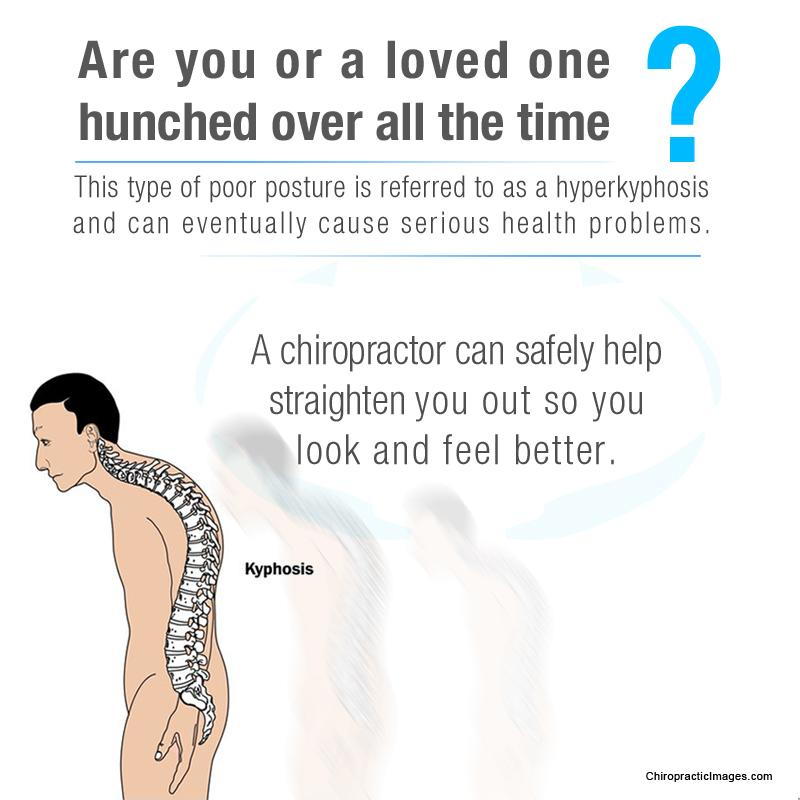
This may seem like a dramatic question, but could poor posture really takes years off your life expectancy? A study completed in 2004 evaluated 1353 elderly patients. Researchers found that patients with a hyperkyphotic posture had a greater rate of mortality by 144%. You have probably noticed someone with this type of posture, where the upper back becomes very rounded and a hump in the back develops. This study showed that as your posture weakens, your chances for dying before your time doubles! Scary, right?!?!
What’s Actually Happening with Weakening Posture?
Your Thoracic spine is naturally curved with the vertebrae stacked on top of each other and separated by intervertebral discs. If your muscles weaken, your spine compensates and often develops degenerative discs and vertebrae. This causes the curve in your spine to increase, along with your back pain and creates less stability. If you look at photos of your grandparents when they were younger, you may have noticed they became shorter as they aged. Did you notice an increased curve in their back? Chances are high that you could!
What Does Hyperkyphosis Look Like?
A person with this condition looks like they are hunched forward with their shoulders rounded inward. A hump called a Dowager’s hump is at the base of their neck. Extreme cases can lead a person to becoming hunched over and relying on a cane in order to remain standing.
How Does a Curved Back Affect Your Health?
Naturally, changing the postural design of the body will alter normal function. People with this condition commonly experience modified respiration and breathing and increased pressure on the spinal cord and nerves. A rounded back stretches the spinal cord and can even put pressure directly on the cord. Pay attention to this because your spinal cord carries all the messages from your brain to your body! Constantly bending forward limits the space your lungs have to expand, which limits the oxygen supply to your heart and body. Less oxygen can lead to serious health issues, including headaches and migraines, dizziness, and chronic fatigue.
Additional health issues caused by postural distortion pattern include:
-
Muscle fatigue
-
Back pain
-
Herniated discs
-
Fractures of the vertebra
-
Arthritis
-
Osteoporosis
What Causes Postural Distortion Patterns?
Habits and lifestyle choices are the biggest factors of postural distortion patterns. It’s most common for people who sit for long periods of time (we see you office workers!). Do you sit at a computer, in a vehicle or at a desk for hours on end every day? If you aren’t intentional about sitting up properly, your core muscles will relax and you will physically lose the ability to sit up straight. It takes a long time for your spine to become distorted, but each day adds up. Good posture is black and white: you either have it or you don’t. Keep reading to learn how you can correct your posture!
How Can I Correct My Posture?
If you have embraced poor posture for 30 years, then it will take time for your body to adjust, but you will get there! It may feel strange at first, but your body will love sitting up properly and you will thank yourself 30 years down the road. Do you have good posture? Great! Keep it up because prevention is vital to being able to walk around without assistance as you age. Three key aspects can re-educate your spine. These are: 1) spinal alignment, 2) postural rehabilitation and 3) postural habits. Chiropractic adjustments improve and maintain the spinal alignment and reduces the tension on the nervous system. This prevents the buildup of poor posture habits and allows the nervous system to communicate properly with the stabilizing muscles.
Specific exercises and stretches help retrain your body to learn proper posture. Doing these, along with chiropractic adjustments will improve the communication and memory of your muscles. Improving your core musculature reduces the risk of injuries, especially if you fall during winter. The fun name for this process is called neuromuscular reeducation and we know your favorite child will enjoy feeling smart rattling this off as they watch you take care of yourself!
An easy way to help improve your posture while sitting at your desk is to put a sticker where you should be looking at eye level. Glance up and readjust. Creating the habit will help you choose good posture more often.
Dr. Rob Lyons and Dr. Brian Marhofer also recommend standing up every 30 minutes and taking the time stretch out your neck, shoulders, and back. Here are some of the best stretches to relieve lower back pain. By taking these approaches to spinal health you will live a lifetime of benefits, and we would love to help you at Grand Traverse Family Chiropractic.
For more information about Grand Traverse Family Chiropractic and the chiropractic techniques used, connect with Dr. Rob and Dr. Brian on the web at www.grandtraversefamilychiro.com and on Facebook at www.facebook.com/grandtraversefamilychiro and www.facebook.com/profile.php?id=100009026113759. Visit the office located in Copper Ridge in Traverse City, Michigan.
References:
Hyperkyphotic Posture Predicts Mortality in Older Community-Dwelling Men and Women: A Prospective Study Journal of the American Geriatrics Society Volume 52 Issue 10 Page 1662 – October 2004. Deborah M. Kado, MD, MS, Mei-Hua Huang, DrPH, Arun S. Karlamangla, MD, PhD, Elizabeth Barrett-Connor, MD and Gail A. Greendale, MD
Impact of a Supervised Worksite Exercise Program on Back and Core Muscular Endurance in Firefighters American Journal of Health Promotion Volume: 29 issue: 3, page(s): 165-172 John M. Mayer, DC, PhD, William S. Quillen, DPT, PhD, Joe L. Verna, DC, Ren Chen, MD, PhD, Paul Lunseth, MD, Simon Dagenais, DC, PhD First Published January 1, 2015
